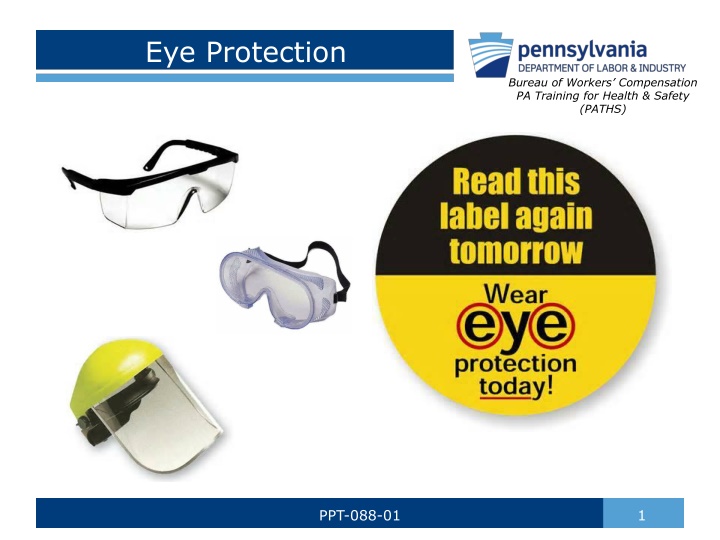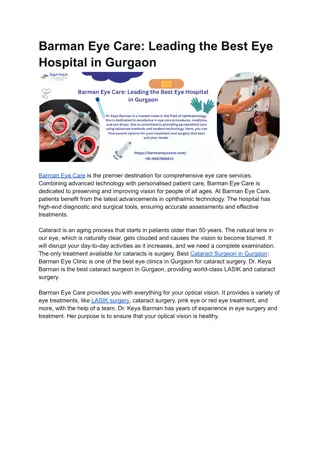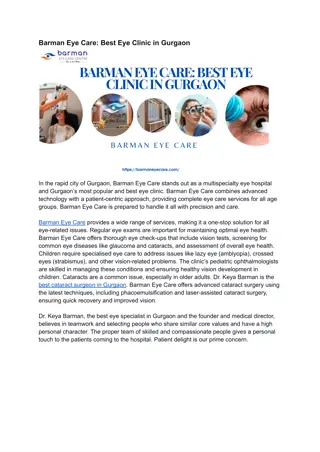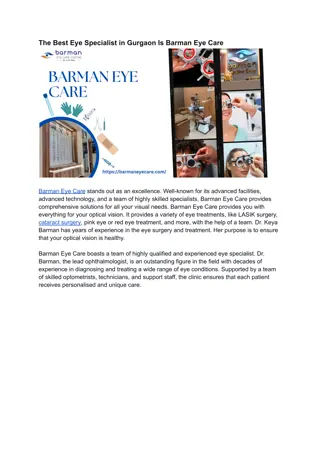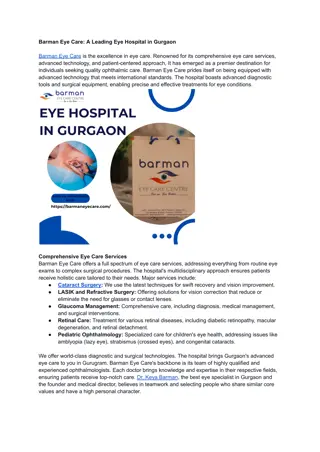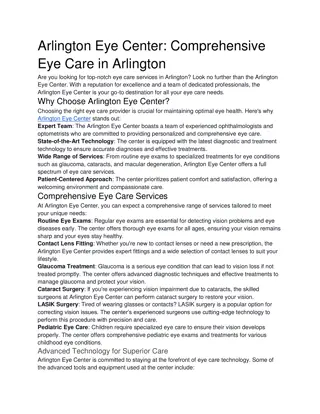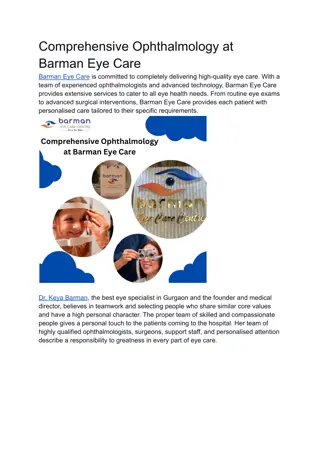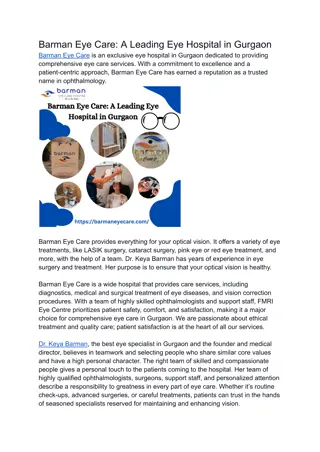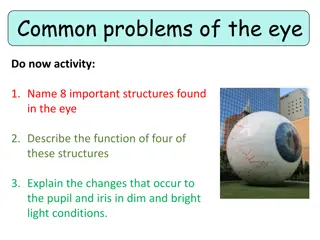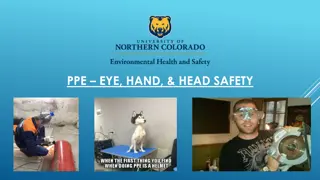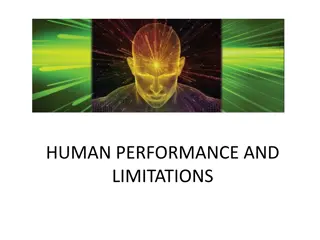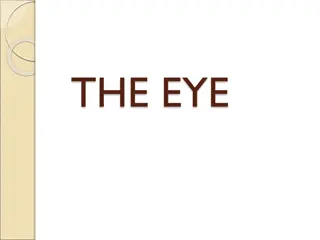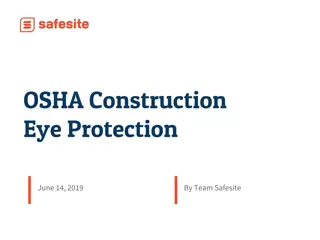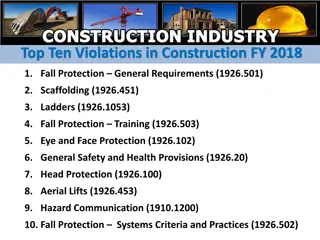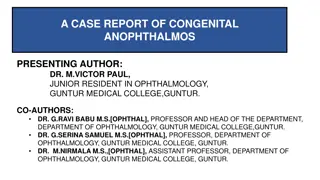Eye Protection Training for Workplace Safety
Understand the importance of proper eye protection at work, including identifying at-risk job functions, selecting the right PPE, and knowing responsibilities for employees and employers. Training covers when PPE is necessary, how to use, maintain, and dispose of it properly, and the need for retraining in certain scenarios. Requirements for PPE include protection, design, comfort, and maintenance. Prescription lenses and contacts must also be considered for proper eye protection against workplace hazards. Remember, PPE should be used in conjunction with other safety measures for comprehensive protection.
Download Presentation

Please find below an Image/Link to download the presentation.
The content on the website is provided AS IS for your information and personal use only. It may not be sold, licensed, or shared on other websites without obtaining consent from the author.If you encounter any issues during the download, it is possible that the publisher has removed the file from their server.
You are allowed to download the files provided on this website for personal or commercial use, subject to the condition that they are used lawfully. All files are the property of their respective owners.
The content on the website is provided AS IS for your information and personal use only. It may not be sold, licensed, or shared on other websites without obtaining consent from the author.
E N D
Presentation Transcript
Eye Protection Bureau of Workers Compensation PA Training for Health & Safety (PATHS) PPT-088-01 1
Objectives Understand the at risk jobs or job functions. Identify the proper eye protection for the job/task. Identify your responsibilities as well as your employer s responsibilities. PPT-088-01 2
Training Employees should be trained to be aware of: When PPE is necessary What kind of PPE is necessary How to properly put on, take off, adjust, and wear PPE The limitations of the PPE The proper care, maintenance, useful life, and disposal of the PPE PPT-088-01 3
Training Retraining should be conducted for the following scenarios (not an all inclusive list): Changes in the workplace Changes in the types of PPE to be used Inadequacies in an employee s knowledge or use of assigned PPE PPT-088-01 4
Requirements PPE must: Provide protection against the particular hazards for which they are designed Be of safe design and construction for the work to be performed Be durable Be distinctly marked Be reasonably comfortable Fit snugly and should not interfere with the movements of the wearer Be capable of being disinfected Be easily cleaned PPT-088-01 5
Contacts & Prescription Lenses Employees who wear prescription (Rx) lenses or contacts must use PPE that incorporates the prescription or use eye protection that can be worn over prescription lenses. PPT-088-01 6
Hazards Employees must be provided with eye and face protection equipment when machines or operations present potential eye or face injury from physical, chemical, or radiation agents. PPT-088-01 7
Hazards PPE devices should not be relied on alone to provide protection against hazards, but should be used in conjunction with guards, engineering controls, and administrative controls. PPT-088-01 8
Hazard Assessment The employer must assess the workplace and determine if hazards that require the use of eye and face protection are present, or are likely to be present, before assigning PPE to workers. A hazard assessment determines the risk of exposure to eye and face hazards, including emergency situations. PPT-088-01 9
Hazard Assessment Hazard Impact Hazard Type Flying objects such as large chips, fragments, particles, sand, and dirt. Anything emitting extreme heat. Splash, fumes, vapors, and irritating mists. Related tasks Chipping, grinding, machining, masonry work, wood working, sawing, drilling, riveting, sanding, etc. Furnace operations, pouring, casting, hot dipping, welding, etc. Acid and chemical handling, degreasing, plating, and working with blood. Woodworking, buffing, and general dusty conditions. Welding, torch-cutting, brazing, soldering, and laser work. Heat Chemicals Dust Harmful dust. Optical Radiation Radiant energy, glare, and intense light PPT-088-01 10
Safety Glasses Safety glasses are intended to shield the wearer's eyes from impact hazards such as flying fragments, objects, large chips, and particles. Workers are required to use safety glasses with side shields when there is a hazard from flying objects. PPT-088-01 11
Safety Glasses & Heat Hazards Safety glasses with side shields are used as primary protection to shield the eyes from heat hazards. To adequately protect the eyes and face from high temperature exposure, use safety glasses in combination with a heat-reflective face shield. PPT-088-01 12
Safety Goggles Safety goggles are intended to shield the wearer's eyes from impact hazards such as flying fragments, objects, large chips, and particles. Goggles fit the face immediately surrounding the eyes and form a protective seal around the eyes. This prevents objects from entering under or around the goggles. PPT-088-01 13
Safety Goggles & Heat Hazards Safety goggles are used as primary protection to shield the eyes from heat hazards. Goggles form a protective seal around the eyes, preventing objects or liquids from entering under or around the goggles. This is especially important when working with or around molten metals that may splash. PPT-088-01 14
Safety Goggles & Dust Hazards Goggles form a protective seal around the eyes, preventing nuisance dust from entering under or around the goggles. Ventilation should be adequate, but well protected from dust entry. PPT-088-01 15
Safety Goggles & Chemical Hazards Safety goggles protect the eyes, eye sockets, and the facial area immediately surrounding the eyes from a variety of chemical hazards. Goggles form a protective seal around the eyes, preventing objects or liquids from entering under or around the goggles. PPT-088-01 16
Face Shields Face shields are intended to protect the entire face, or portions thereof, from impact hazards such as flying fragments, objects, large chips, and particles. When worn alone, face shields do not protect employees from impact hazards. Use face shields in combination with safety spectacles or goggles for additional protection. PPT-088-01 17
Face Shields & Heat Hazards Heat-reflective and wire-screen face shields are intended to shield the entire face from a range of heat hazards. Face shields are considered secondary protectors to be used inaddition to primary protection such as safety glasses or goggles. PPT-088-01 18
Face Shields & Chemical Hazards Face shields are intended to protect the entire face from a variety of chemical hazards. All face shields are considered secondary protection and must be used inaddition to safety goggles to provide adequate protection. PPT-088-01 19
Filter Lenses Wearing protection with the correct filter shade number is required to protect workers eyes from optical radiation. When selecting PPE, consider the type and degree of radiant energy in the workplace. PPT-088-01 20
Welding Welding helmets are secondary protectors intended to shield the eyes and face from optical radiation, heat, and impact. Use welding helmets in addition to primary protection such as safety glasses or goggles to provide adequate protection. PPT-088-01 21
Lasers Workers with exposure to laser beams must be furnished suitable laser safety goggles which will: Protect for the specific wavelength of the laser Be of optical density adequate for the energy involved PPT-088-01 22
Glare Control Glare with: Special-Purpose Spectaclesthat include filter or special-purpose lenses to provide protection against eye strain. Changes in your work area or lighting Tinted eyeglass lenses or visor-type shade PPT-088-01 23
Eye Protection Care Here are some tips for keeping eyes protection in the best shape possible: Keep eye protection clean continuous use of dirty lenses can cause eyestrain. Replace pitted and/or deep scratched lenses because they reduce vision and have a greater potential to break. Conduct daily inspection of eye protection. PPT-088-01 24
Eye Protection Care Disinfect eye protection by thoroughly cleaning all parts with soap and warm water. Rinse off all traces of soap and replace any defective parts. PPT-088-01 25
Summary When employees are trained to work safely they should be able to anticipate and avoid injury from job-related hazards. PPT-088-01 26
Contact Information Health & Safety Training Specialists 1171 South Cameron Street, Room 324 Harrisburg, PA 17104-2501 (717) 772-1635 RA-LI-BWC-PATHS@pa.gov Like us on Facebook! - https://www.facebook.com/BWCPATHS PPT-088-01 27
Questions PPT-088-01 28
